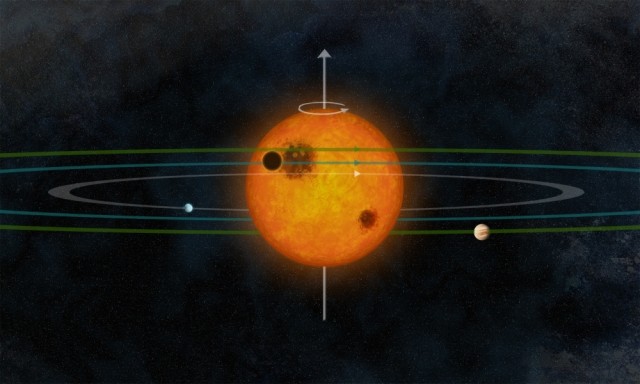Three-planet system's regular orbits hint at orbital chaos elsewhere
Systems evolve from one disk then have orbital interactions destabilize them.
by Matthew Francis - July 26 2012
The Solar System is remarkably regular, its eight planets orbiting the Sun in the same direction in very nearly circular trajectories. Their orbits lie nearly in the same plane, which is aligned with the Sun's equator. These facts point toward a common origin for the Solar System, where everything collapsed from a single protostellar disk.
However, many exoplanetary systems are very different: exoplanets often orbit in highly elliptical orbits, and some "hot Jupiters" (giant planets in very small orbits) even revolve in the opposite direction from their host stars. A current major challenge in astrophysics is to understand why irregular systems exist.
The exoplanet system Kepler-30 could provide some help. A new analysis by Roberto Sanchis-Ojeda and colleagues showed the three known planets in the system orbit in a regular fashion: nearly circular orbits aligned with the rotation of the host star Kepler-30a. The researchers found the Kepler-30 system to be as orderly as the Solar System, leading them to suggest that misaligned hot Jupiter systems arise from interactions among the planets, rather than a different process of planet formation.
The regularity of the largest bodies in the Solar System is striking, especially in contrast with other known exoplanet systems. (In fact, other than Venus and Uranus, planets in the Solar System even rotate around their axes the same direction.) One measure of this regularity is the fact that the planes of our planets' orbits are very close to the Sun's equator. This can be quantified as the stellar obliquity, which is the angle between the star's angular momentum and the angular momentum of each planet. The direction of the angular momentum is found by curling the fingers of your right hand in the direction of rotation or orbit; your thumb points in the direction of the vector. If the angular momentum of the star and a planet's orbit are nearly the same, the stellar obliquity is small.
The eight planets in the Solar System all have small stellar obliquities, but many hot Jupiter systems do not. In some cases, host stars may even rotate in the opposite direction to the revolution of its planets. The most commonly accepted planet formation model predicts that planets and their stars form from a single disk of gas and dust. All the objects in the system revolved the same direction the disk rotated; this provides an excellent explanation for the uniformity of our Solar System.
Rotations can't be measured for every star: starspots need to be present in the data. With only a few exceptions, stars are too far away and too small for direct imaging of their surfaces, so starspots are found via fluctuations in the star's light. To be detected, the starspots have to be significantly larger than sunspots, and so rotation has been measured for only a few stars bearing relatively huge starspots.
Despite this handicap, the researchers determined Kepler-30a's rotation rate to be about 16 days at the latitude of the starspot. (Stars don't rotate at the same rate for every point on the surface, since they are not solid. For example, the Sun rotates once about every 25 days at the equator, but it takes longer at the poles.) From that relatively rapid rotation, they concluded Kepler-3a is younger than the Sun, since stars slow down as they age. (Don't we all?)
Using 2.5 years of Kepler telescope data, the researchers found instances where more than one of the exoplanets passed successively across the same starspot group. This verified both the direction and the plane of orbit for each planet in the system within a range of values, which were consistent with a Solar System-like model. Independent measurements of the planets' orbits showed them to be nearly circular as well.
While Kepler-30 is just one star system, its regularity places it in the same category as the Solar System, making it very different from many exoplanet systems containing hot Jupiters. The authors argue that this could be an indication that hot Jupiters got where they are via orbital interactions with other planets. If other multi-planet systems have similarly low obliquities, then it's unlikely that protoplanetary disks formed out of alignment with the equators of the host stars. The starspot transit method laid out in this paper should help resolve whether all multiple-planet systems are similarly regular to Kepler-30 and the Solar System.

No comments:
Post a Comment